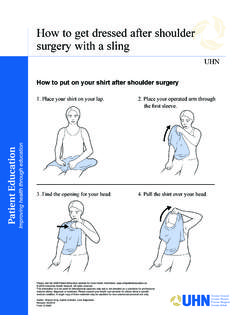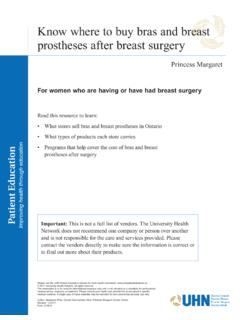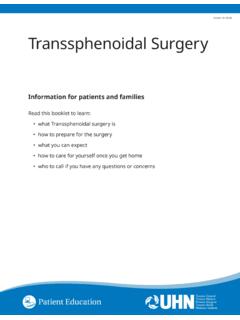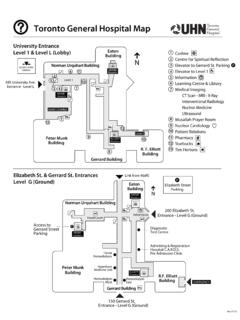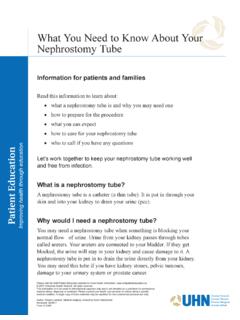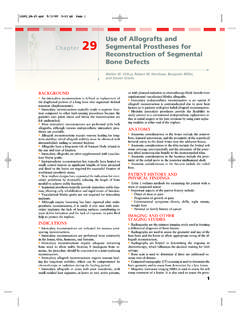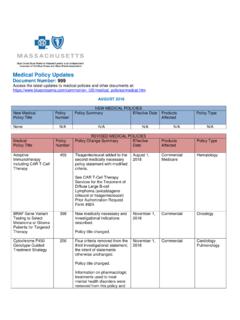Transcription of PMH CLINICAL PRACTICE GUIDELINES TEMPLATE - …
1 PRINCESS MARGARET CANCER CENTRE CLINICAL PRACTICE GUIDELINES GENITOURINARY PROSTATE CANCER 2 Last Revision Date October 2015 GU Site Group Prostate Cancer Authors: Dr. Charles Catton, Dr. Anthony Joshua 1. INTRODUCTION 3 2. PREVENTION 3 3. SCREENING AND EARLY DETECTION 3 4. DIAGNOSIS 4 5. PATHOLOGY 5 6. MANAGEMENT 6 ADENOCARCINOMA OF PROSTATE 6 LOW RISK INTERMEDIATE RISK HIGH RISK PRESENTATION WITH N1 OR M1 DISEASE MANAGEMENT OF PROGRESSION AFTER INITIAL THERAPY ONCOLOGY NURSING PRACTICE 13 7.
2 SUPPORTIVE CARE 14 PATIENT EDUCATION 14 PSYCHOSOCIAL CARE 14 SYMPTOM MANAGEMENT 14 CLINICAL NUTRITION 14 PALLIATIVE CARE 14 OTHER 14 8. FOLLOW-UP CARE 15 9. APPENDIX 1 PATHOLOGICAL CLASSIFICATION 16 10. APPENDIX 2 TESTICULAR CANCER STAGING 18 3 Last Revision Date October 2015 1. UINTRODUCTIONU Prostate cancer is the most frequently diagnosed cancer in Canadian males accounting for of new cases and 11% of all cancer deaths (Canadian Cancer Statistics 2008). Diagnosis is most frequently made between the ages of 60-69.
3 The average annual change in age-standardized incidence increased by from 1995-2004. This increase is attributed to the introduction of prostate cancer screening during the interval. The natural history of prostate cancer is variable, but it is frequently indolent with an age standardized mortality rate of ,000 in 2008 compared to 209/100,000 for all cancers. Death from prostate cancer most frequently occurs over the age of 79 ( of deaths), and is uncommon before the age of 70 ( of deaths). The average annual age-standardized mortality decreased in Canada by from1995-2004 and this improvement is attributed to both an artifact resulting from earlier diagnosis as well as improvement in management that occurred during this interval.
4 2. UPREVENTIONU The use of 5- reductase inhibitors finasteride and dutasteride compared to placebo have been shown to reduce the risk of being diagnosed with prostate cancer among regularly screened men during the observation interval of two randomized control trials (Prostate Cancer Prevention Trial and the Reduction by Dutasteride of Prostate Cancer Events). No cause specific or overall survival advantage has been shown to date, and the advantages of chemoprevention with 5- reductase inhibitors include delayed or prevented prostate cancer treatment and reduced anxiety over diagnosis.
5 Complications of 5- reductase inhibition include increase in sexual and erectile dysfunction and the possible induction of higher grade prostate cancer. The routine use of chemoprevention with finasteride or dutasteride is not recommended, and the risks and benefits of chemoprevention of prostate cancer should be discussed with potential candidates before initiating a program. 3. USCREENING AND EARLY DETECTIONU The PRACTICE of routine screening for prostate cancer remains controversial since supporting evidence is conflicting (NEJM editorials Nov 24, 2011).
6 Routine screening for Ontario men is not recommended by CancerCare Ontario and not supported by the Ontario Ministry of Health and Long Term Care. If screening is considered desirable, it should only be undertaken following a discussion of the potential risks of overtreatment as well as the potential benefits of early diagnosis. 4 Last Revision Date October 2015 Screening is not recommended for men under 50 unless there is a family history of prostate cancer, and should not be continued beyond age 75.
7 Screening investigations include an annual serum Prostatic Specific Antigen (PSA) determination and a digital rectal examination (DRE). Diagnosis of suspected prostate cancer is confirmed with a transrectal ultrasound guided needle biopsy. Sextant pattern sampling is the minimum recommended procedure. A 12+ sector sampling, with or without lateral horn sampling is standard at UHN. Patients with a high suspicion of cancer and a previous negative biopsy should undergo prostate magnetic resonance imaging (MRI) to exclude the presence of an anteriorly situated tumor.
8 4. UDIAGNOSIS Diagnosis of prostate cancer is made with a trans-rectal ultrasound guided needle biopsy. Sextant pattern sampling is the minimum recommended procedure. We consider 12-17 cores to be routine. Patients diagnosed following transurethral resection of prostate (TURP) should also undergo a trans-rectal ultrasound guided biopsy to establish the pattern and extent of intra-prostatic disease. Multiparametric MRI should be considered to rule out anterior or far lateral tumours for patients with a high suspicion of disease and negative ultrasound guided biopsies.
9 At the initial assessment, patients (particularly those with potentially curable cancers requiring multimodality input and/or treatment) should be assessed in a multidisciplinary environment. CLINICAL Evaluation: Complete history in all patients Record of lower urinary symptomatology and erectile function Co-morbid conditions (previous cancers, heart disease, cerebrovascular disease, diabetes, renal dysfunction) Prior treatment of cancer, if any Complete physical examination in all patients, including DRE Voiding studies for patients under consideration for prostate brachytherapy Oncologic Imaging and Laboratory Evaluations: Evaluation of local extent of disease.
10 All patients should undergo a diagnostic trans-rectal ultrasound and DRE to establish prostate volume and local extent of disease. Prostate MRI may provide complementary information concerning local disease extent in patients with suspected T3a or T3b disease. 5 Last Revision Date October 2015 Metastatic Workup: Imaging is undertaken to determine the presence of nodal or skeletal metastases in high-risk individuals, or in those with signs or symptoms suggestive of metastatic disease. A contrast-enhanced CT of the abdomen and pelvis to detect metastases in pelvic or abdominal lymph-nodes is limited to patients with Gleason score 8-10 disease or a PSA U>U 20 or neuroendocrine dedifferentiation.




